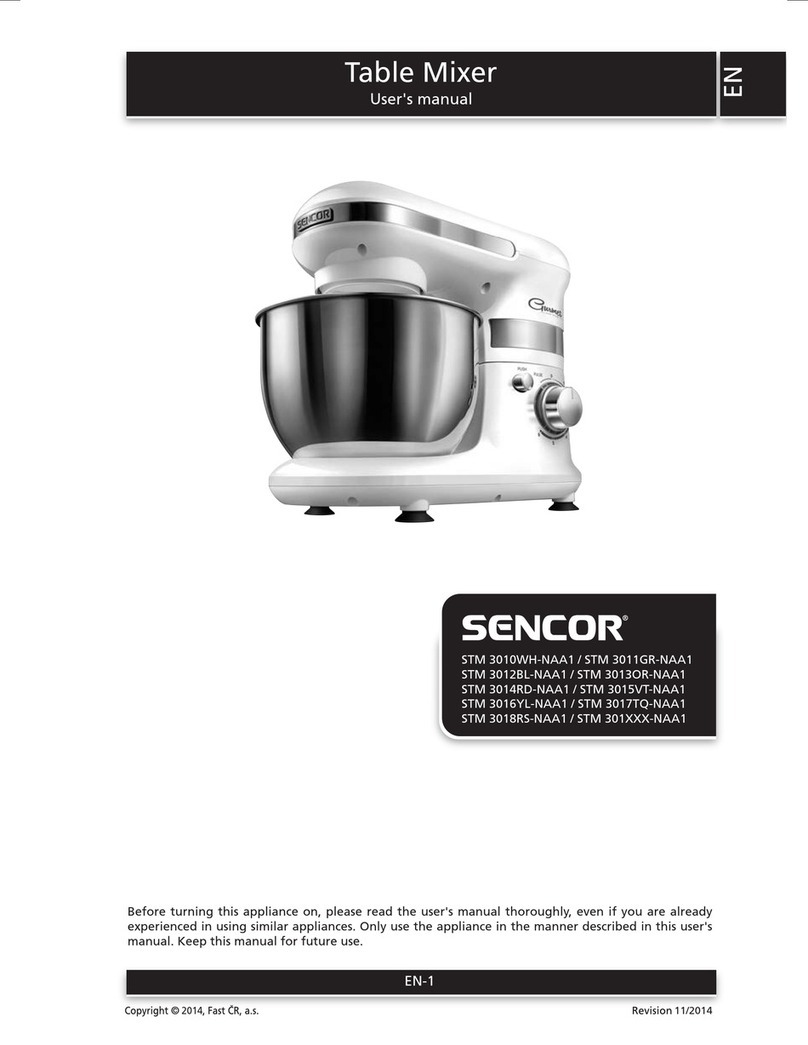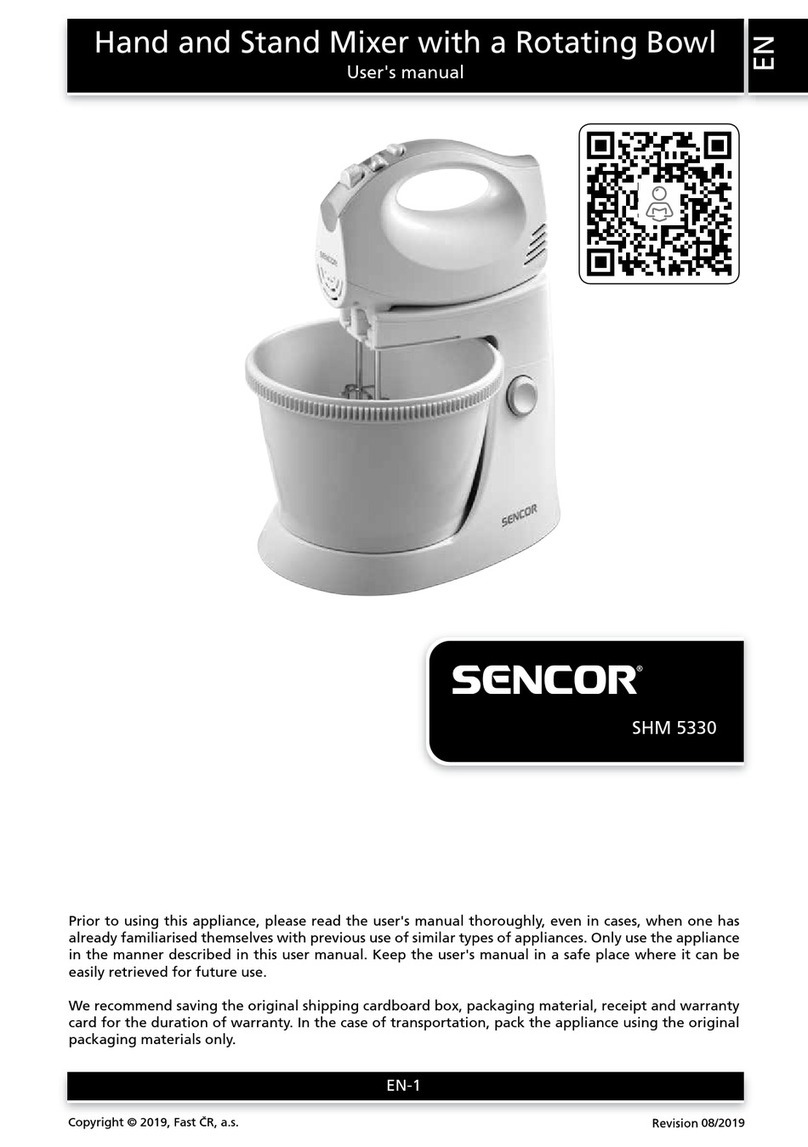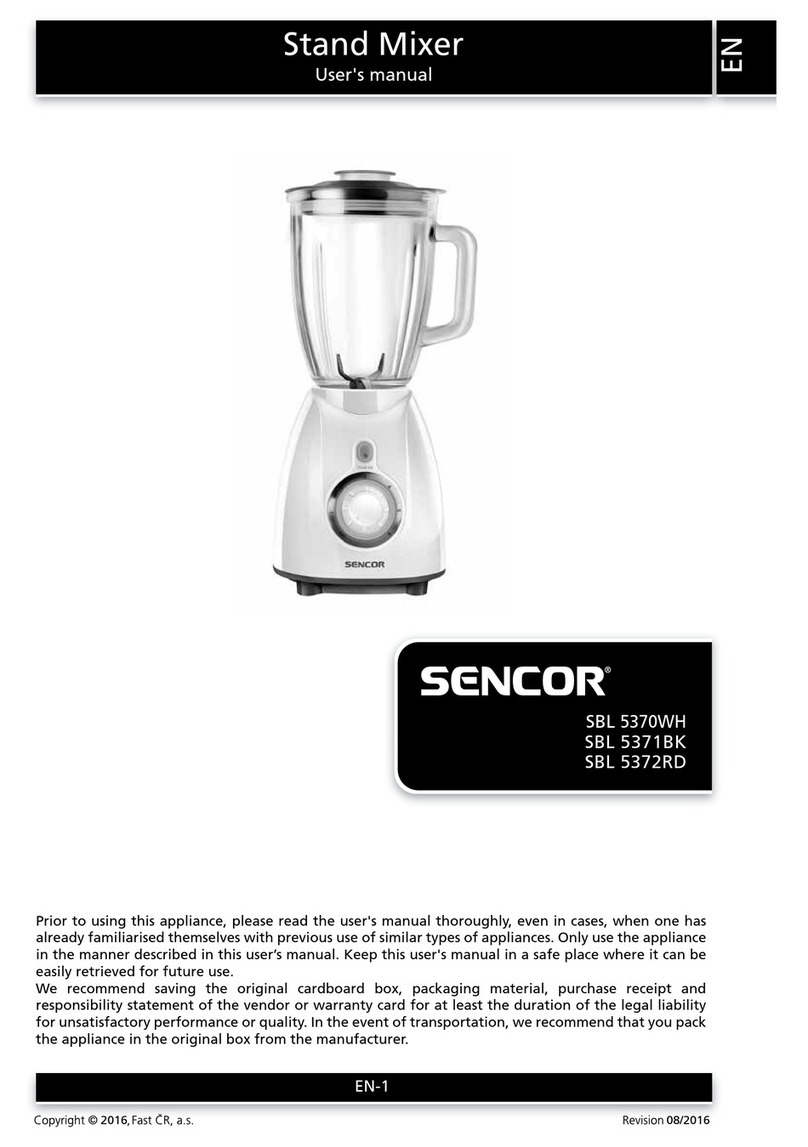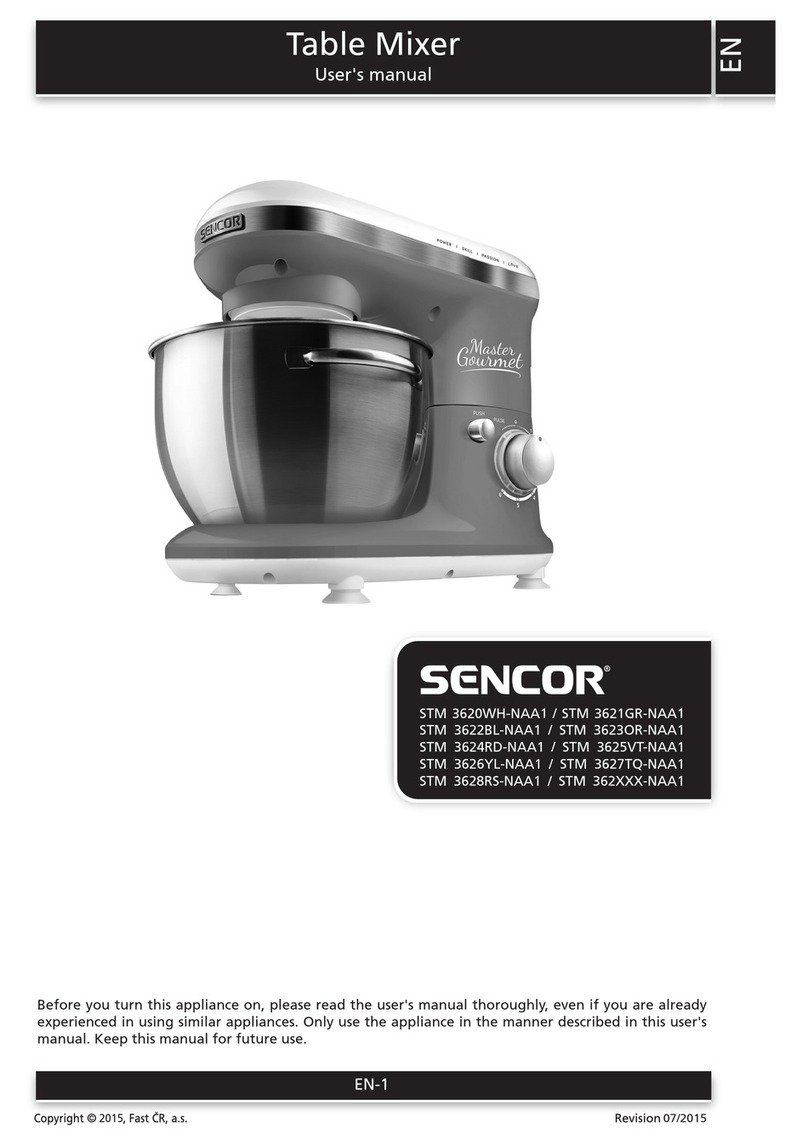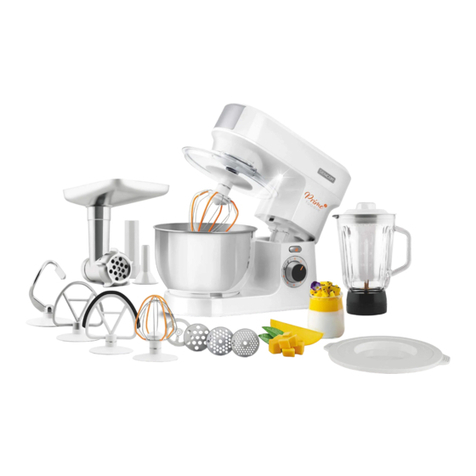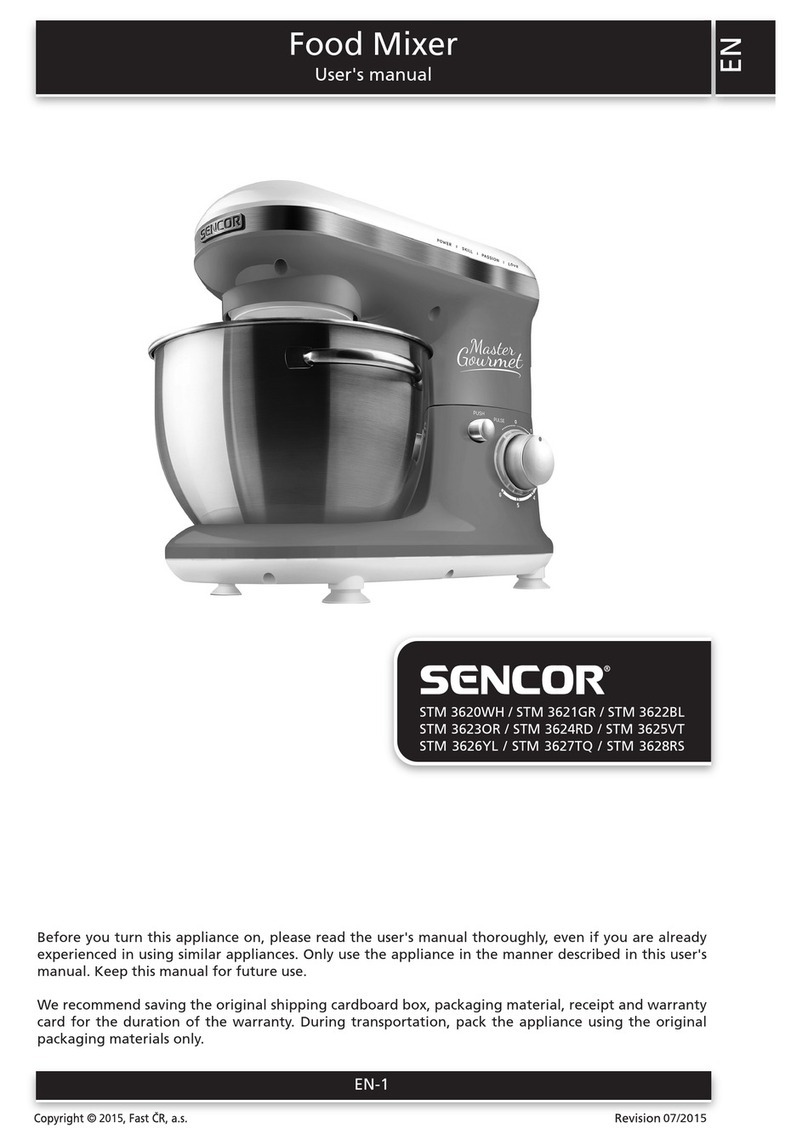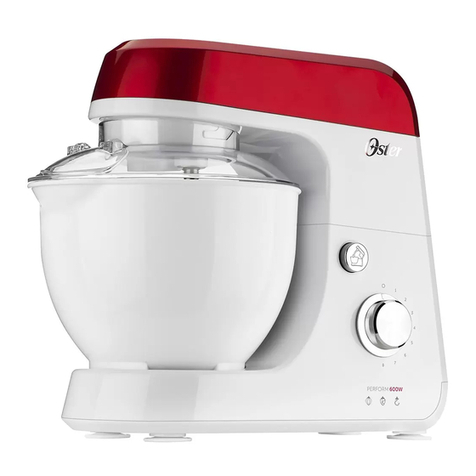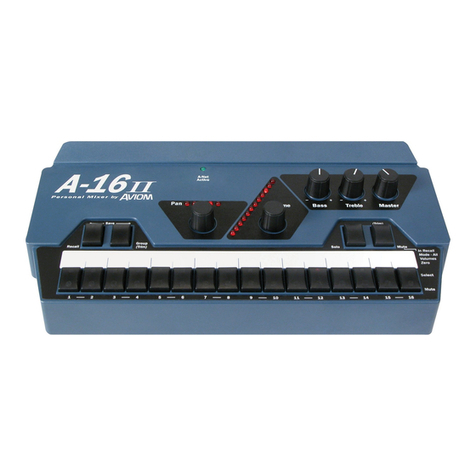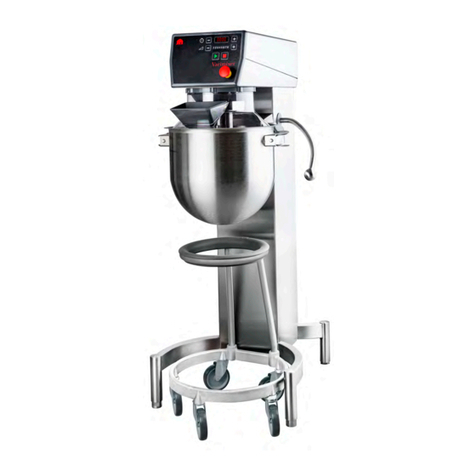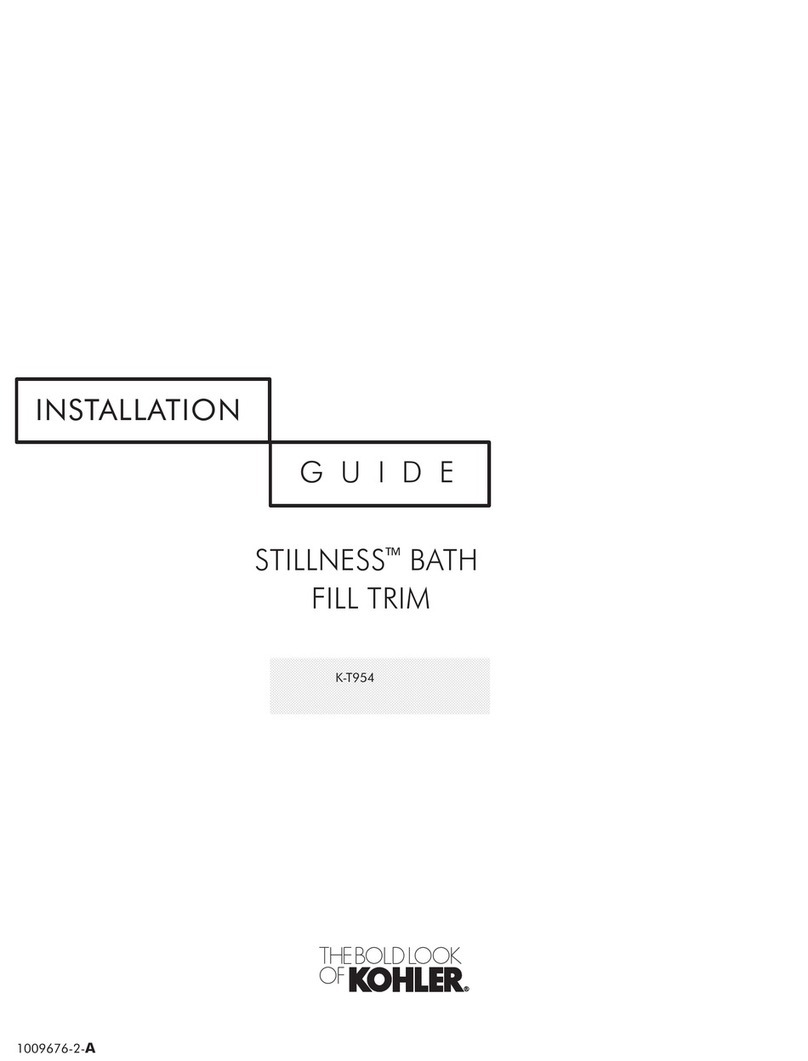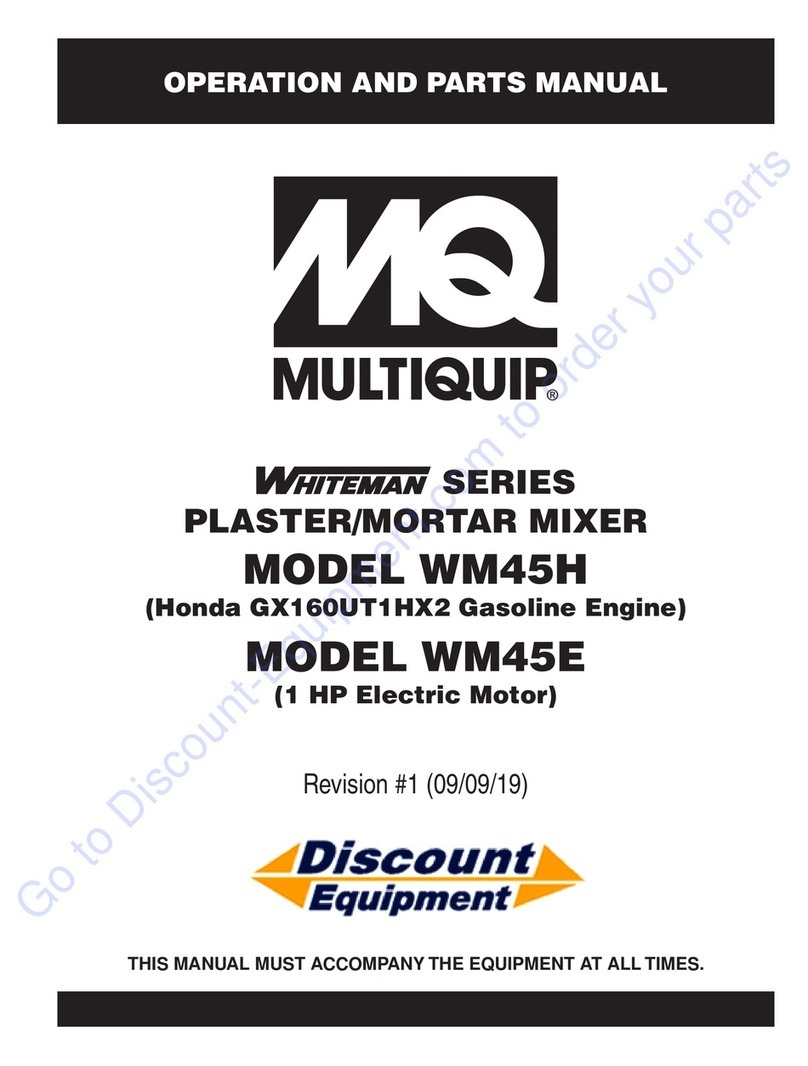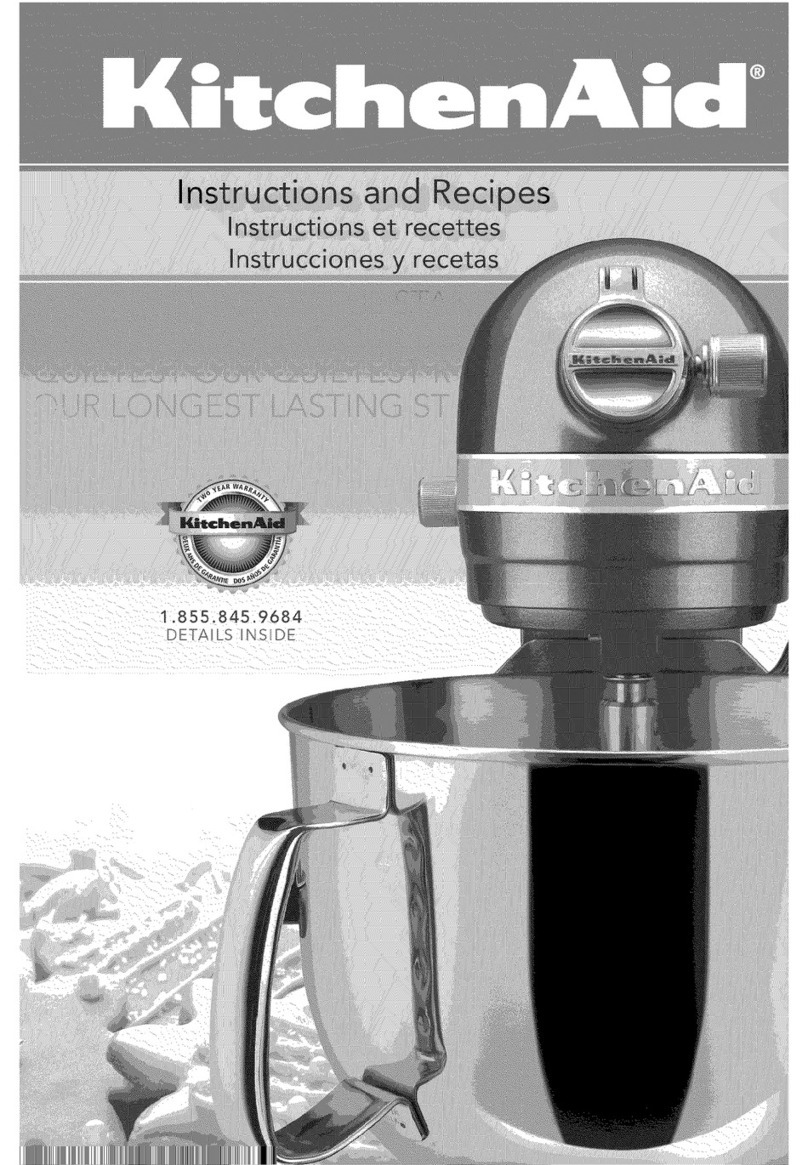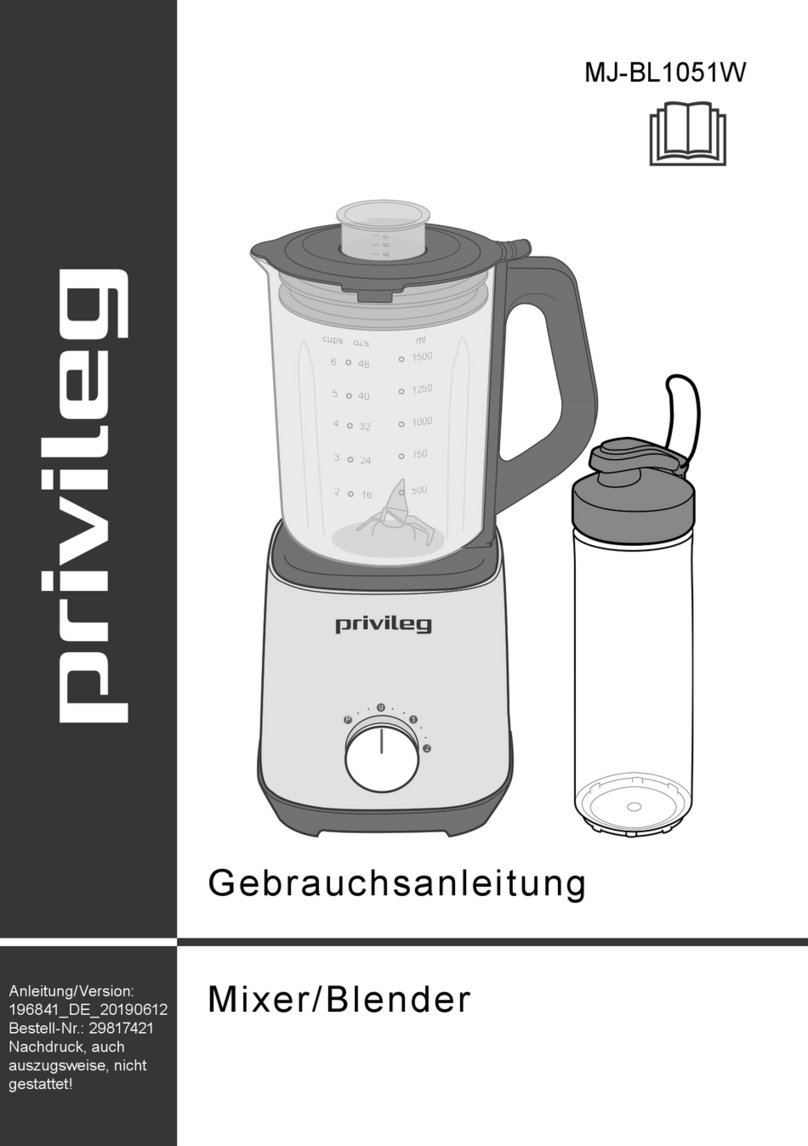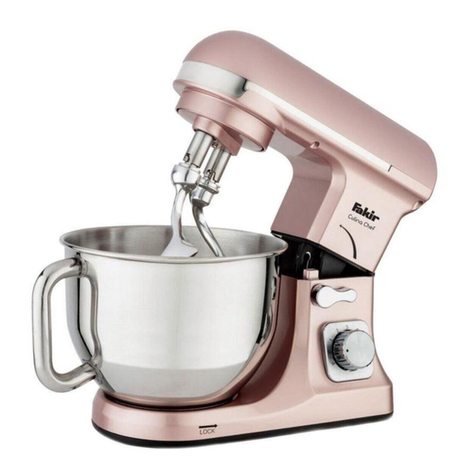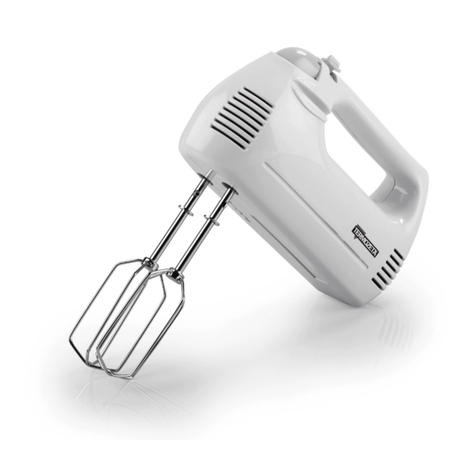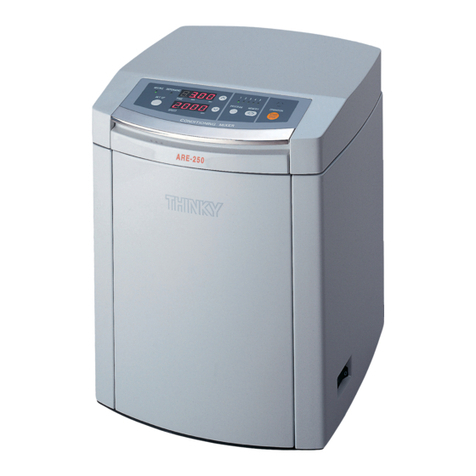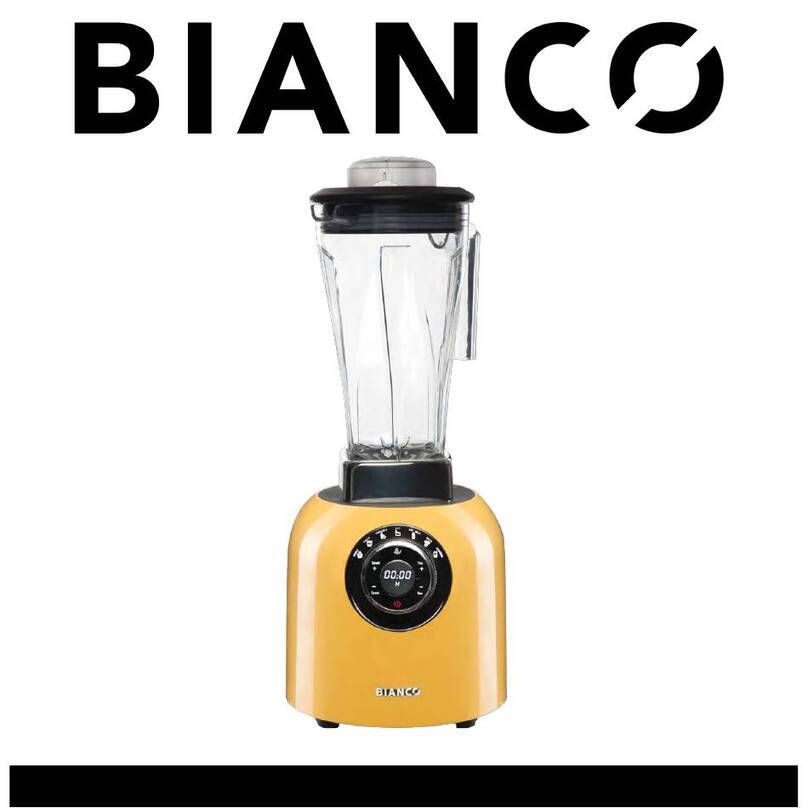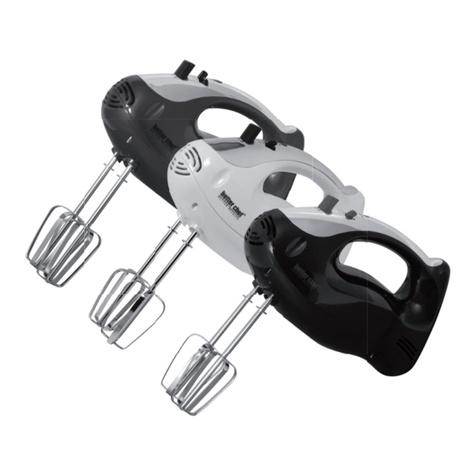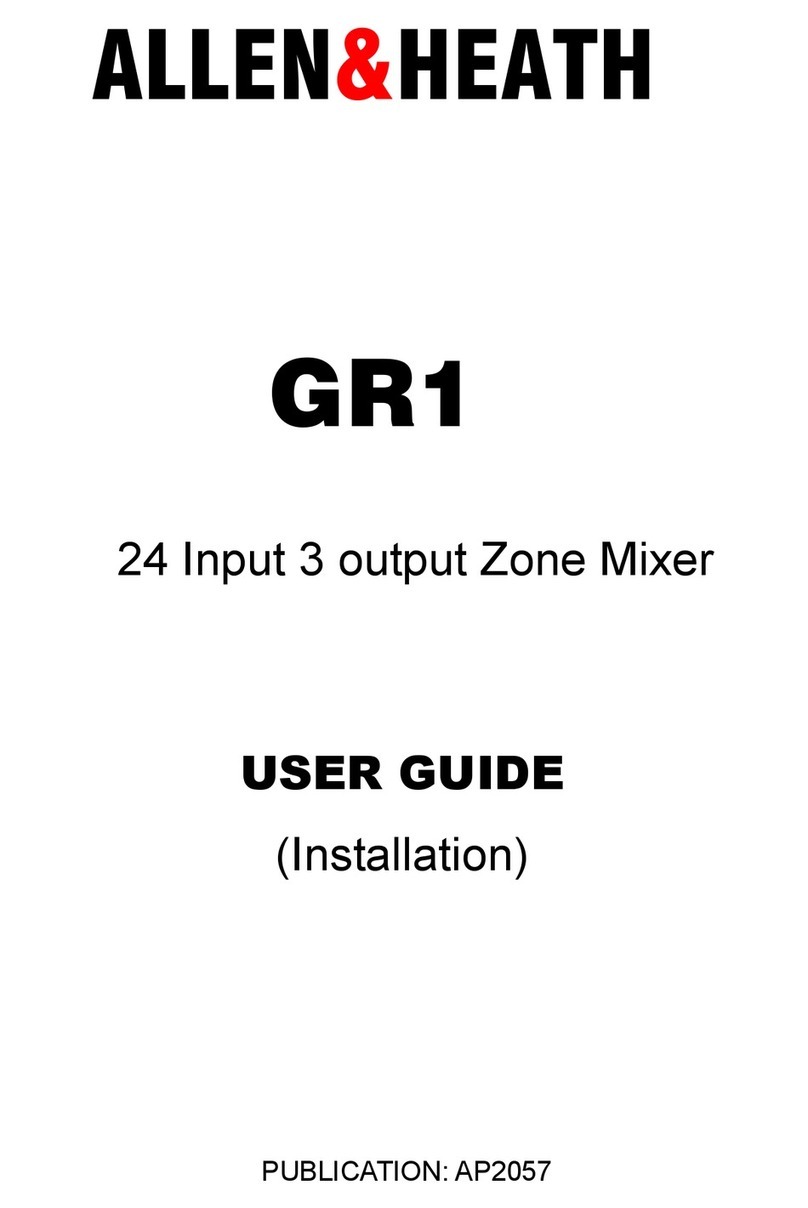
- 7 - 09/2019
Copyright © 2019, Fast ČR, a.s.
EN Stand mixer
User'smanual
DESCRIPTION OF THE APPLIANCE AND ACCESSORIES
A1 Kneading hook
A2 Elastic balloon whisk
A3 A-shaped beater
A4 Elastic A-shaped beater
A5 Anti-splash transparent lid
A6 Bowl lid
A7 4-litre stainless steel bowl
A8 Base unit
A9 Mixing head withshaft for
mounting attachments A1, A2, A3
or A4
A10 Top removable lid
A11 Hub for the blender
A12 Tilt-out arm with open position lock
A13 LED illumination
A14 PUSH button for releasing the arm
A15 Illuminated speed control knob
– 0 (turned off to stand-by mode)
– speed level setting 1, 2, 3, 4, 5, 6
(52, 87, 112, 122, 136 and172 rpm)
–- blending mode
–
- smoothie mode
A16 Anti-slip feet with suction cups
A17 Compartment for winding up the
power cord
A18 Inner cap
A19 Outer lid
A20 Blending jar with 1.5 l capacity
A21 Removable blade assembly
A22 0.6-litre nutri-bottle
It is made from very durable Tritan
plastic.
A23 Removable blade assembly
with titanium-coated chopping
blades
A24 Lid with aclosable drinking spout
BEFORE FIRST USE
■ Prior to using this appliance, please read the user’smanual thoroughly, even in cases,
when one has already familiarised themselves with previous use of similar types of
appliances. Only use the appliance in the manner described in this user’smanual.
Keep this user’smanual in asafe place where it can be easily retrieved for future use.
In the event that you hand this appliance over to somebody else, make sure to also
include this user’smanual.
■ We recommend saving the original cardboard box, packaging material, purchase
receipt and responsibility statement of the vendor or warranty card for at least the
duration of the legal liability for unsatisfactory performance or quality. In the event
of transportation, we recommend that you pack the appliance in the original box
from the manufacturer.
1. Carefully unpack the appliance and take care not to throw away any part of the
packaging before you find all the parts of the appliance.
2. Thoroughly all parts (kneading hook A1, elastic balloon whisk A2, A-shaped beater
A3, elastic A-shaped beater A4, lid A5, A6, stainless steel mixing bowl A7, blending
jar A20 with lids A18 and A29, nutri- bottle A22 lid A24 and both blade assemblies
A21 and A23), that are intended to come into contact with food using warm water
and aneutral kitchen detergent. Then rinse them with clean water and dry them
thoroughly with afine wiping cloth.
Attention:
When cleaning blade assemblies A21 and A23, take special care
to avoid injury on the sharp cutting edges.
BEATING, WHIPPING AND KNEADING
PLANETARY MIXING SYSTEM
■ The planetary mixing system is based on the principle of dual rotation of the
attachment. The attachment rotates anticlockwise along the inner perimeter of the
bowl while rotating around its own axis in the opposite direction. This ensures that
ingredients inside the bowl are processed thoroughly and evenly.
SELECTING ATTACHMENT TYPES
ATTACHMENT TYPE PURPOSE OF USE
Kneading hook A1 It is used for kneading and preparing heavy and thick
doughs containing yeast, e.g. bread dough.
A-shaped beater A3
and elastic A-shaped
beater A4
It is used for mixing medium heavy and lighter doughs not
containing yeast, for mixing sauces, creams, fillings, etc.
Balloon whisk A2
It is used for whisking whole eggs or egg whites, whipped
cream, light doughs, foamy creams, etc. Do not use it for
mixing heavy and thick doughs.
ASSEMBLY AND DISASSEMBLY
■ Before you start assembling or disassembling the food processor, check that it is
turned off and disconnected from the el. power socket.
1. Inserting the mixing bowl
1.1 Place the food processor on an even, dry surface, for example on a kitchen
countertop.
1.2 Release the arm A12 by pressing the PUSH button A14 and tilt it upwards. The
arm is locked in the open position when the PUSH button A14 slides out together
with an audible click.
1.3 Place the stainless steel bowl A7 into the hole in the base unit A8 and secure
it in place by turning it clockwise. When the bowl is properly attached, it is not
possible to lift it off the base unit.
2. Attaching an attachment (kneading hook, beater or whisk)
2.1 If you decide to use the transparent lid A5, then it is necessary to attach it prior to
mounting any attachment. Carefully seat the lid on to the tilt-out arm and secure
it in the locked position by turning it anticlockwise.
2.2 When attaching an attachment, the arm A12 must be secured in the open
position, see point 1.2 in chapter Inserting the mixing bowl. Attach one of the
attachments to theT-shaped shaft of the mixing head A9 so that the shaft fits into
the hole on the attachment. Push the attachment towards the mixing head and
turn it anticlockwise to secure it to the shaft.
2.3 With one hand, hold the attachment and gently pull it downwards. If it is properly
secured to the shaft, it will not come off.
2.4 If you will not be immediately placing ingredients into the mixing bowl A7, press
the PUSH button A14 and tilt the arm A12 to the horizontal position. When
the arm is tilted to the horizontal position, the PUSH button A14 will slide out
accompanied by an audible click.
3. Removing the attachments and mixing bowl
3.1 Release the arm A12 by pressing the PUSH button A14 and tilt it upwards. The
arm is locked in the open position when the PUSH button A14 slides out together
with an audible click.
3.2 Hold the attachment and gently push it towards the mixing head A9. Then rotate
it clockwise until it is released from the motor shaft and take it off.Turn the mixing
bowl A7 anticlockwise and take it off the base unit A8. Move the arm A12 back to
the horizontal position.
OPERATION
1. Unwind the necessary length of power cord from the compartment A17.
2. Release the arm A12, by pressing the PUSH button A14 and tilt it out.
3. Put the ingredients into the bowl A7 and place the bowl into the base unit A8.
Attention:
The maximum weight of the ingredients that can be processed
in asingle batch is 1.6 kg. When preparing bread dough, do not
process more than 600 g of flour at once. When preparing dough
for sweet pastries (fruit cakes, etc.) it is not possible to process
more than 450 g of flour in asingle batch. The maximum number
of egg whites that can be whisked at once is 8.
4. Press the PUSH button A14 and tilt the arm A12 together with the attached
attachment to the horizontal position.
5. Make sure that the food processor is correctly assembled and that the speed control
knob A15 is set to position 0 (stand-by mode). Connect the power cord to an el.
power socket.
6. Use the speed control knob A15 to set the required speed level from 1 to 6. First,
set alower speed to prevent ingredients from being splattered around. As soon as
they are mixed together, increase the speed to the required level. The speed can be
adjusted at any time as required.
Attention:
If it is necessary to wipe ingredients off the inside of the mixing
bowl A7 and the attachment, first turn off the food processor
by setting the speed control knob A15 to position 0 (stand-by
mode) and then disconnect it from the power socket. Then wipe
away the ingredients using aplastic spatula.
The maximum operating time is 6 minutes. Do not leave the
appliance in continuous operation for longer than indicated
above. This is especially true under a heavy load (e.g. when
processing heavy, thick doughs). If the appliance is in operation
under heavy load, allow it to cool down for at least 10 minutes
before turning it on again. At lower loads, acooling time of 3 to 5
minutes is usually sufficient.
In the event that the appliance runs non-stop for 10 minutes, it
will stop automatically.
7. After you have finished using the appliance, set the speed control knob A15 to
position 0 (stand-by mode) and disconnect the power cord from the power socket.
8. Disassemble the food processor according to the instructions included in chapter
Assembling and disassembling the appliance. Use asoft plastic spatula to remove
mixes from the mixing bowl A7 and the attachment.
9. Clean out the food processor after each use according to the instructions in chapter
Cleaning and maintenance.
QUICK GUIDE TO BEATING WHIPPING WITH KNEADING
Attachment type Ingredients Amount Processing
time
Speed
selection
Elastic balloon whisk A2 Egg whites max.8 pcs 4 minutes Level 6
Elastic balloon whisk A2 Cream 500 ml 4-5 minutes Level 6
Elastic balloon whisk A2 Mayonnaise 3 egg yolks 1 minute Level 2-4
Beater A3 Cake dough approx. 800 g 6 minutes Level 2-6
Kneading hook A1 Bread dough max.600 g of
flour 4 minutes Level 2
